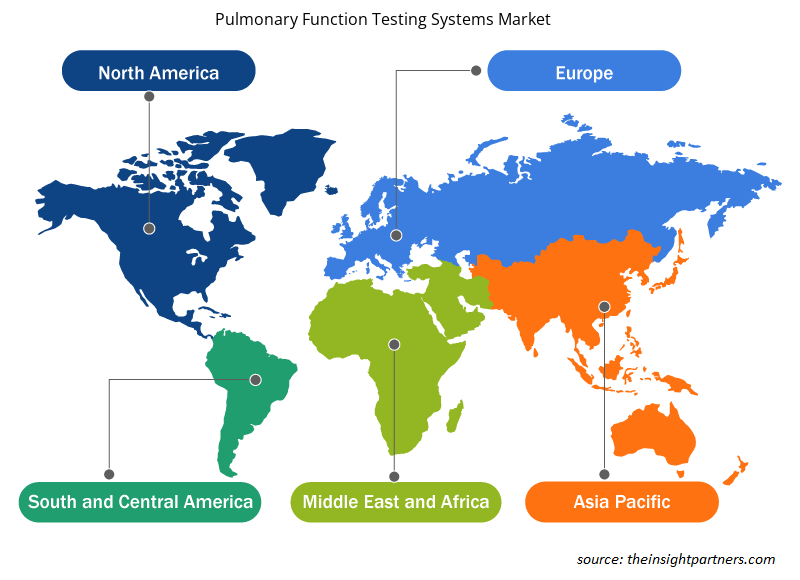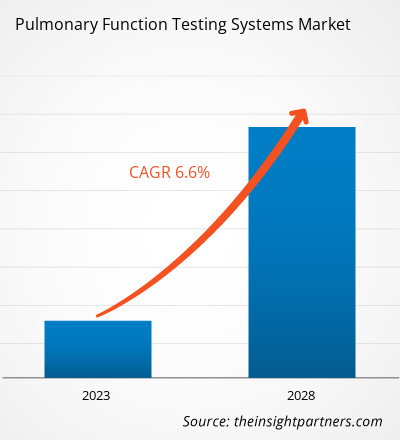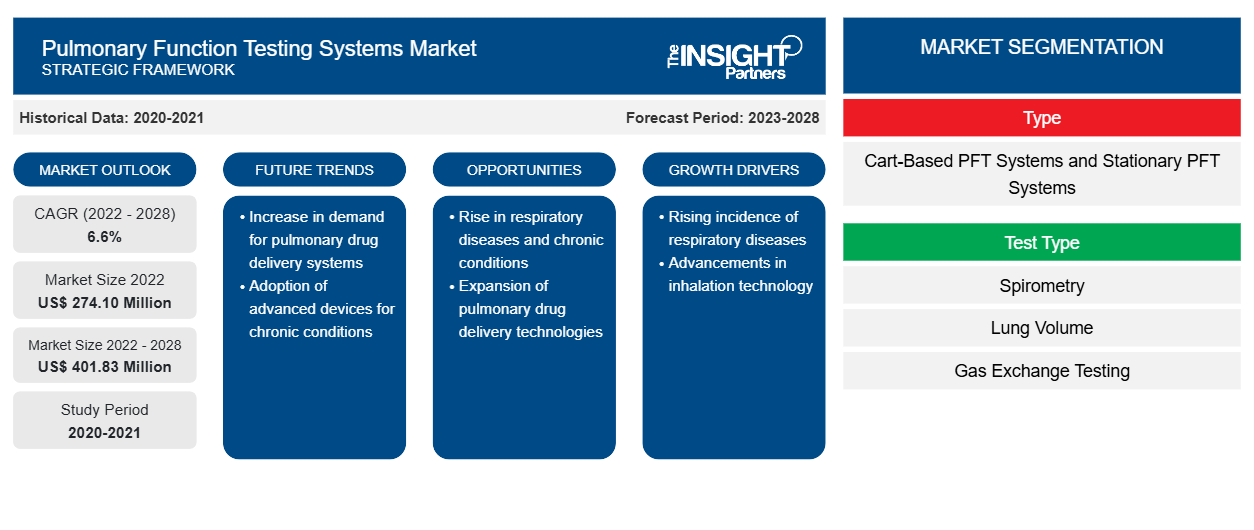Si prevede che il mercato dei sistemi di test della funzionalità polmonare raggiungerà i 401,83 milioni di dollari entro il 2028, rispetto ai 274,10 milioni di dollari del 2022. Si stima che il mercato dei sistemi di test della funzionalità polmonare registrerà un CAGR del 6,6% dal 2022 al 2028.
Il test di funzionalità polmonare (PFT) è un set di test non invasivi utilizzati per misurare il funzionamento dei polmoni di un paziente. Questi test sono importanti per diagnosticare e curare le persone con malattie respiratorie. Per eseguire i test e ottenere risultati accurati, è importante utilizzare i tipi giusti di apparecchiature e macchine PFT. Il sistema di test di funzionalità polmonare è composto da diversi dispositivi utilizzati per misurare diversi aspetti della funzionalità polmonare. Ciò può includere quanto bene i polmoni assorbono ed espellono aria, quanto efficientemente trasferiscono ossigeno al sangue e quanta aria possono contenere. I PFT misurano i volumi polmonari, le capacità e la quantità di scambio di gas. La crescente incidenza di disturbi correlati ai polmoni e malattie polmonari professionali sta contribuendo alla crescita delle dimensioni del mercato dei sistemi di test di funzionalità polmonare . Tuttavia, il rischio di contaminazione incrociata e la mancanza di professionisti qualificati stanno ostacolando la crescita del mercato.
Il mercato dei sistemi di test della funzionalità polmonare è stato segmentato in base a tipo, tipo di test, componente, applicazione, utente finale e area geografica. In termini di area geografica, il mercato è principalmente segmentato in Nord America, Europa, Asia Pacifico, Medio Oriente e Africa e Sud e Centro America. Il rapporto offre approfondimenti e analisi approfondite del mercato, sottolineando parametri quali tendenze del mercato dei sistemi di test della funzionalità polmonare, progressi tecnologici, dinamiche di mercato e analisi del panorama competitivo dei principali attori del mercato.
Personalizza questo report in base alle tue esigenze
Riceverai la personalizzazione gratuita di qualsiasi report, comprese parti di questo report, o analisi a livello nazionale, pacchetto dati Excel, oltre a usufruire di grandi offerte e sconti per start-up e università
-
Scopri le principali tendenze di mercato in questo rapporto.Questo campione GRATUITO includerà analisi di dati che spaziano dalle tendenze di mercato alle stime e alle previsioni.
Approfondimenti di mercato
Aumento dell'incidenza delle malattie polmonari
Secondo il rapporto 2023 della British Lung Foundation, ogni settimana nel Regno Unito circa 10.000 persone ricevono una diagnosi di malattia polmonare. Inoltre, le malattie polmonari sono responsabili di oltre 70.000.000 di ricoveri ospedalieri, con 6 milioni di giorni di degenza ospedaliera nel Regno Unito ogni anno. Pertanto, i sistemi di test della funzionalità polmonare (PFT) si dimostrano utili nella diagnosi e nel monitoraggio. I sistemi PFT forniscono risultati accurati, in particolare volume polmonare, capacità, velocità di flusso e scambio di gas. Inoltre, l'utilizzo dei sistemi PFT aiuta a valutare il trattamento per asma, enfisema e altri problemi polmonari cronici. Attraverso la valutazione di volumi polmonari, capacità, velocità di flusso e scambio di gas, i PFT possono fornire informazioni che possono essere valutate dai medici per aiutare a diagnosticare efficacemente determinati disturbi polmonari e decidere il trattamento giusto per i pazienti. Inoltre, i PFT sono procedure non invasive e sono solitamente raccomandati dai medici per i pazienti senza degenza ospedaliera. I sistemi commerciali di test della funzionalità polmonare disponibili sul mercato includono la spirometria . Il test spirometrico è utile per determinare se il paziente soffre di una malattia polmonare, il tipo di malattia polmonare, la progressione della malattia polmonare e il deterioramento della malattia polmonare. La spirometria misura il flusso d'aria e può valutare un'ampia gamma di malattie polmonari tra i pazienti. Pertanto, la crescente incidenza di disturbi correlati ai polmoni sta alimentando l'uso di sistemi di test della funzionalità polmonare.
Informazioni basate sul tipo
In base al tipo, il mercato dei sistemi di test della funzionalità polmonare è segmentato in sistemi PFT basati su carrello e sistemi PFT fissi. Il segmento basato su carrello ha detenuto una quota maggiore del mercato nel 2022. Inoltre, si prevede che il segmento basato su carrello registrerà un CAGR più elevato nel mercato durante il periodo di previsione.
Informazioni basate sul tipo di test
In termini di tipo di test, il mercato dei sistemi di test della funzionalità polmonare è stato segmentato in spirometria, volume polmonare, test di scambio gassoso, ventilazione volontaria massima, test di titolazione dell'ossigeno e altri. Il segmento della spirometria ha detenuto la quota maggiore del mercato nel 2022. Inoltre, si prevede che il segmento del volume polmonare registrerà il CAGR più elevato nel mercato durante il periodo di previsione.
Approfondimenti basati sui componenti
In base al componente, il mercato dei sistemi di test della funzionalità polmonare è stato segmentato in hardware, software e servizi. Il segmento hardware ha detenuto la quota maggiore del mercato nel 2022. Si prevede che il segmento software registrerà il CAGR più elevato nel mercato durante il periodo di previsione.
Approfondimenti basati sulle applicazioni
In base all'applicazione, il mercato dei sistemi di test della funzionalità polmonare è stato segmentato in broncopneumopatia cronica ostruttiva (BPCO) , asma, mancanza di respiro cronica, malattie polmonari restrittive e altri. Il segmento della broncopneumopatia cronica ostruttiva (BPCO) ha detenuto la quota maggiore del mercato nel 2022. Inoltre, si prevede che lo stesso segmento registrerà il CAGR più elevato nel mercato durante il periodo di previsione.CAGR in the market during the forecast period.
Informazioni basate sull'utente finale
In base all'utente finale, il mercato dei sistemi di test della funzionalità polmonare è stato segmentato in ospedali, cliniche specialistiche e centri diagnostici. Il segmento degli ospedali ha detenuto la quota maggiore del mercato nel 2022. Si prevede che il segmento delle cliniche specialistiche registrerà il CAGR più elevato nel mercato durante il periodo di previsione.CAGR in the market during the forecast period.
Il COVID-19 è un'infezione dell'apparato respiratorio che può causare rapidamente sintomi simili alla polmonite e infezioni toraciche. Ciò può comportare un peggioramento delle condizioni di salute del paziente. I ventilatori aiutano a gestire lo scambio di gas dei pazienti. A causa dell'epidemia di COVID-19, c'era una domanda molto elevata di sistemi di test della funzionalità polmonare. L'American Lung Association e i Centers for Disease Control and Prevention hanno raccomandato che i pazienti con sintomi lievi di COVID-19 eseguano test della funzionalità polmonare per controllare la capacità polmonare del paziente. Il test della funzionalità polmonare è uno strumento ideale per valutare l'impatto fisiologico di un virus che attacca in gran parte il sistema cardiopolmonare. La tecnologia che misura il flusso d'aria, i volumi polmonari e la capacità di ossigeno e anidride carbonica di trasferirsi tra gli alveoli e il flusso sanguigno è ben consolidata e le strutture per eseguire questi test si trovano in tutti gli Stati Uniti.
Le aziende nel mercato dei sistemi di test della funzionalità polmonare adottano comunemente lanci di prodotti e strategie di espansione per espandere la propria presenza in tutto il mondo e soddisfare la crescente domanda. La loro attenzione all'innovazione di prodotto consente loro di soddisfare le mutevoli richieste dei clienti e di mantenere il proprio marchio in tutto il mondo.
- A giugno 2022, ndd Medical Technologies (ndd) ha aggiornato l'intera gamma di prodotti EasyOne, inclusi EasyOne Air, Easy on-PC, EasyOne Pro ed EasyOne Pro LAB, per renderli conformi alla standardizzazione ATS/ERS della spirometria 2019.
- Ad aprile 2021, Vyaire Medical ha annunciato il lancio europeo di ArtiQ.PFT, uno strumento automatizzato basato sull'intelligenza artificiale che interpreta istantaneamente i test di funzionalità polmonare (PFT). ArtiQ.PFT è la prima soluzione PFT basata su cloud che sfrutta l'intelligenza artificiale.
In termini geografici, il mercato globale dei sistemi di test della funzionalità polmonare è suddiviso in Nord America (Stati Uniti, Canada e Messico), Europa (Francia, Germania, Regno Unito, Spagna, Italia e resto d'Europa), Asia Pacifico (Cina, India, Giappone, Australia, Corea del Sud e resto dell'APAC), Medio Oriente e Africa (Arabia Saudita, Emirati Arabi Uniti, Sudafrica e resto dell'area MEA) e Sud e Centro America (Brasile, Argentina e resto del Sud e Centro America).APAC), the Middle East & Africa (Saudi Arabia, the UAE, South Africa, and the Rest of MEA), and South & Central America (Brazil, Argentina, and the Rest of South & Central America).
Approfondimenti regionali sul mercato dei sistemi di test della funzionalità polmonare
Le tendenze regionali e i fattori che influenzano il mercato dei sistemi di test della funzionalità polmonare durante il periodo di previsione sono stati ampiamente spiegati dagli analisti di Insight Partners. Questa sezione discute anche i segmenti di mercato dei sistemi di test della funzionalità polmonare e la geografia in Nord America, Europa, Asia Pacifico, Medio Oriente e Africa e Sud e Centro America.

- Ottieni i dati specifici regionali per il mercato dei sistemi di test della funzionalità polmonare
Ambito del rapporto di mercato sui sistemi di test della funzionalità polmonare
| Attributo del report | Dettagli |
|---|---|
| Dimensioni del mercato nel 2022 | 274,10 milioni di dollari USA |
| Dimensioni del mercato entro il 2028 | 401,83 milioni di dollari USA |
| CAGR globale (2022 - 2028) | 6,6% |
| Dati storici | 2020-2021 |
| Periodo di previsione | 2023-2028 |
| Segmenti coperti |
Per tipo
|
| Regioni e Paesi coperti |
America del Nord
|
| Leader di mercato e profili aziendali chiave |
|
Sistemi di test della funzionalità polmonare: densità degli attori del mercato: comprendere il suo impatto sulle dinamiche aziendali
Il mercato dei sistemi di test della funzionalità polmonare sta crescendo rapidamente, spinto dalla crescente domanda degli utenti finali dovuta a fattori quali l'evoluzione delle preferenze dei consumatori, i progressi tecnologici e una maggiore consapevolezza dei benefici del prodotto. Con l'aumento della domanda, le aziende stanno ampliando le loro offerte, innovando per soddisfare le esigenze dei consumatori e capitalizzando sulle tendenze emergenti, il che alimenta ulteriormente la crescita del mercato.
La densità degli operatori di mercato si riferisce alla distribuzione di aziende o società che operano in un particolare mercato o settore. Indica quanti concorrenti (operatori di mercato) sono presenti in un dato spazio di mercato in relazione alle sue dimensioni o al valore di mercato totale.
Le principali aziende che operano nel mercato dei sistemi di test della funzionalità polmonare sono:
- SCHILLER
- COSMED srl
- Società di diagnostica MGC
- Ganshoran Medizin elettronico
- ndd Tecnologie Mediche
Disclaimer : le aziende elencate sopra non sono classificate secondo un ordine particolare.

- Ottieni la panoramica dei principali attori del mercato dei sistemi di test della funzionalità polmonare
Profili aziendali
- COSMED Srl
- MGC Diagnostica Corpo
- Morgan Scientific Inc
- Minato Medical Science Co Ltd
- Schiller AG
- Cassa MI Inc
- Vyaire Medical Inc
- ndd Tecnologie mediche Inc
- Dispositivi medici avanzati PulmOne Ltd
- KoKo PFT Ltd
- Analisi storica (2 anni), anno base, previsione (7 anni) con CAGR
- Analisi PEST e SWOT
- Valore/volume delle dimensioni del mercato - Globale, Regionale, Nazionale
- Industria e panorama competitivo
- Set di dati Excel
Report recenti
Rapporti correlati
Testimonianze
Motivo dell'acquisto
- Processo decisionale informato
- Comprensione delle dinamiche di mercato
- Analisi competitiva
- Analisi dei clienti
- Previsioni di mercato
- Mitigazione del rischio
- Pianificazione strategica
- Giustificazione degli investimenti
- Identificazione dei mercati emergenti
- Miglioramento delle strategie di marketing
- Aumento dell'efficienza operativa
- Allineamento alle tendenze normative























 Ottieni un campione gratuito per - Mercato dei sistemi di test della funzionalità polmonare
Ottieni un campione gratuito per - Mercato dei sistemi di test della funzionalità polmonare